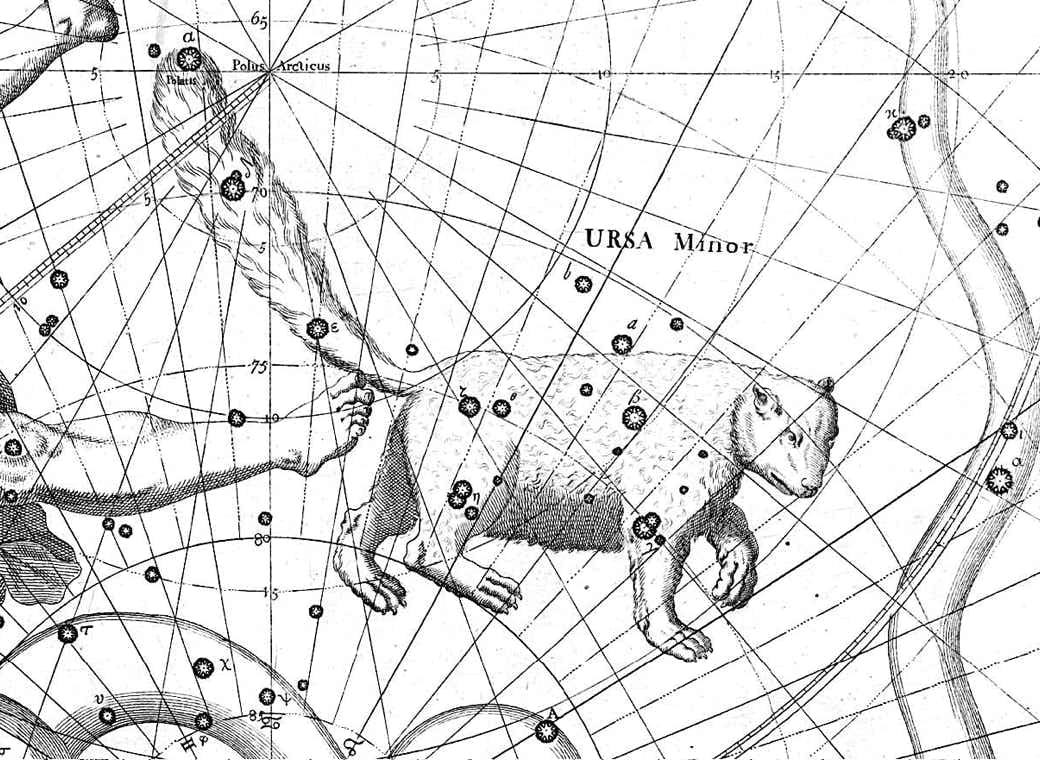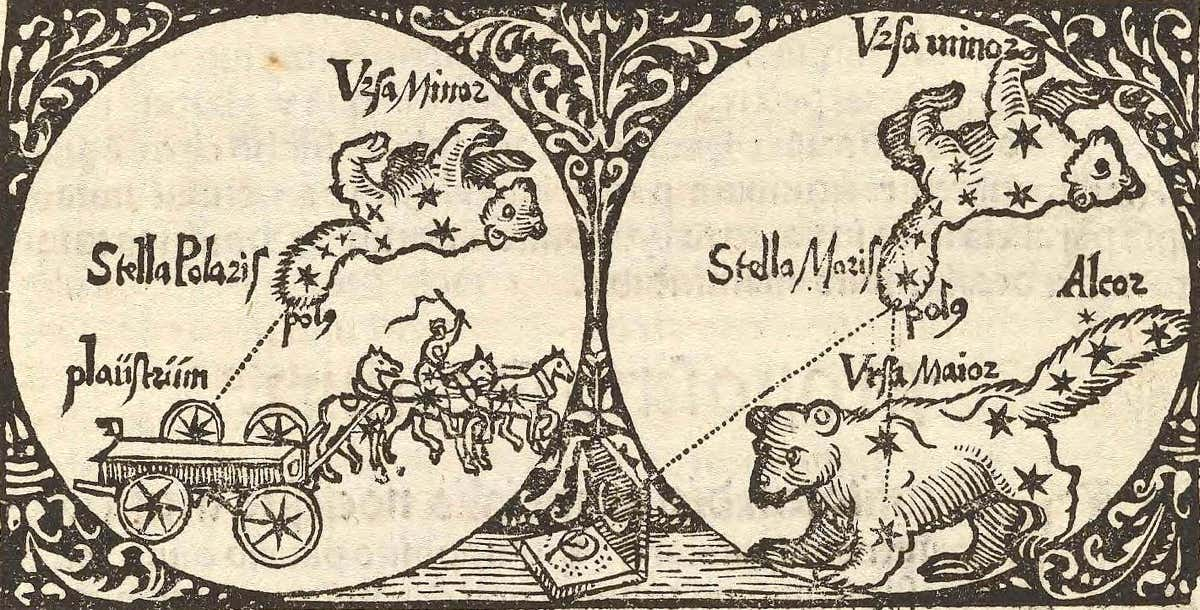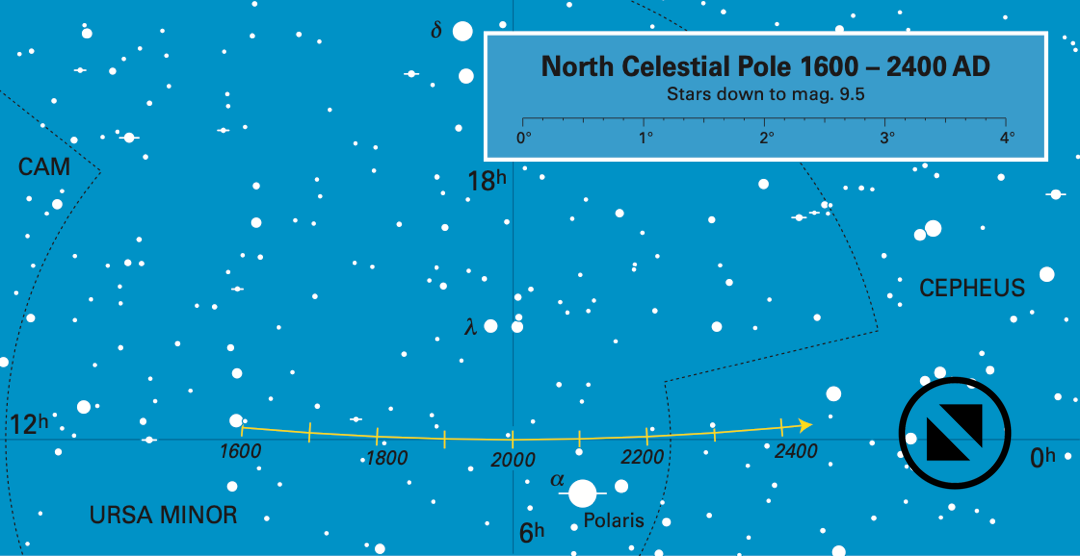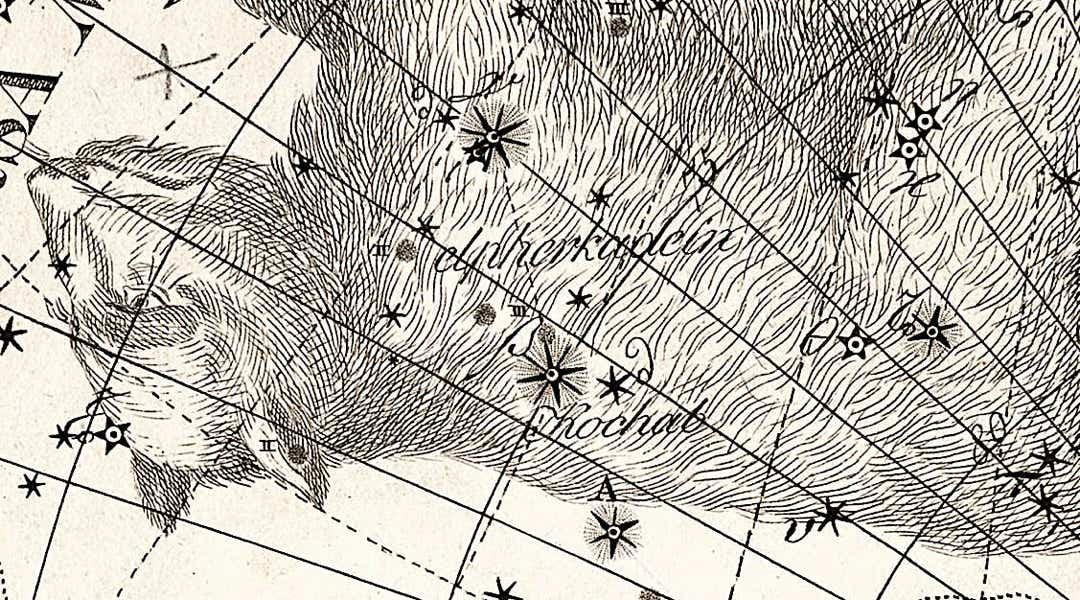
Genitive: Ursae Minoris
Abbreviation: UMi
Size ranking: 56th
Origin: One of the 48 Greek constellations listed by Ptolemy in the Almagest
Greek name: Ἄρκτος Μικρά (Arktos Mikra)
The Little Bear was said by the Greeks to have been first named by the astronomer Thales of Miletus, who lived from about 625 to 545 BC. The earliest reference to it seems to have been made by the Greek poet Callimachus of the third century BC, who reported that Thales ‘measured out the little stars of the Wain [wagon] by which the Phoenicians sail’. The little bear was evidently unknown to Homer, two centuries before Thales, for he wrote only of the Great Bear, never mentioning its smaller counterpart.
It is not clear whether Thales invented the constellation himself or merely introduced it to the Greeks, for Thales was reputedly descended from a Phoenician family and, as Callimachus said, the Phoenicians navigated by reference to Ursa Minor rather than Ursa Major. Aratus, a contemporary of Callimachus, pointed out that although the Little Bear is smaller and fainter than the Great Bear, it lies closer to the pole and hence provides a better guide to true north. Eratosthenes tells us that the Greeks also knew Ursa Minor as Φοινίκη (Phoenike), i.e. the Phoenician. In the sky the two bears stand back to back, facing in opposite directions, with the tail of Draco the dragon between them.
Ursa Minor from the Atlas Coelestis of John Flamsteed (1729).
Polaris, the north pole star, lies at the tip of its unnaturally long tail.
In Flamsteed’s time, Polaris was 2°.3 from the celestial pole.
According to Aratus the two bears were placed in the sky by Zeus to commemorate the two nymphs who nursed him as an infant in the cave of Dicte on Crete, although there is no explanation of why they were represented as bears. Apollodorus tells us that the nurses’ names were Adrasteia and Ida; Ursa Minor commemorates Ida while Adrasteia, the senior of the two, is Ursa Major. Aratus called the Little Bear Κυνόσουρα (i.e. Kynosoura, or Cynosura in Latin transliteration), Greek for ‘dog’s tail’. This is the origin of the English word cynosure, meaning ‘guiding star’. Cynosura was still in use as an alternative name for Ursa Minor in Tycho Brahe’s star catalogue published in 1602.
In the Almagest Ursa Minor appears under the Greek name Ἄρκτος Μικρά (Arktos Mikra). Ptolemy catalogued seven stars as part of the Little Bear, four in the body and three in the tail; an eighth star (the modern-day 5 UMi) was also listed but was regarded as lying outside the constellation. These seven stars have a similar ladle shape to the Big Dipper of Ursa Major, and so are popularly termed the Little Dipper. At the end of the Little Bear’s tail (or the dipper’s handle) is the star Alpha Ursae Minoris, commonly known by the Latin name Polaris because it is currently the nearest bright star to the north celestial pole, although that has not always been the case.
Polaris and the north celestial pole
In Ptolemy’s day (2nd century AD) there was no bright star near the north celestial pole. The star we know as Polaris was then some 11° away. Kochab (Beta Ursae Minoris) was closer, but only by a couple of degrees. Over the ensuing centuries, though, the effect of precession slowly moved the celestial pole towards Alpha Ursae Minoris.
According to the German star-name expert Paul Kunitzsch, the first known usage of the name ‘stella polaris’ applied to this star in print was in an edition of the Alfonsine Tables (an updated version of Ptolemy’s Almagest) published in Venice in 1492. The name Stella Polaris also occurs on a globe of 1493 by Johannes Stöffler (1452–1531) and in books by Stöffler and Peter Apian (1495–1552), illustration below, in the early 16th century. At that time, Polaris was still around three and a half degrees from the celestial pole, five times farther than it is at present, but was clearly becoming accepted as the pole star. Prior to that, the closest star of any note to the pole was 5th-magnitude Struve 1694 (aka HR 4893) in Camelopardalis.[note]
One of the earliest appearances of the name Stella Polaris was in 1524 on this diagram of the polar region from a book called Cosmographicus Liber by the German astronomer and mathematician Peter Apian (1495–1552). On the right Polaris is given the alternative name Stella Maris, Latin for star of the sea, in reference to its use for navigation. Here the constellations are shown reversed, as on a celestial globe. Later editions of the book contain a different diagram in which the constellations are shown the right way round and the name Stella Polaris is used on both halves of the chart.
Contrary to common belief, Polaris is not particularly bright. It is in fact of magnitude 2.0, just on the fringe of the top 50 brightest stars as seen by the naked eye. Currently it lies within 1° of the exact north celestial pole, close enough to make it an excellent guide star for navigators. Polaris will reach its closest to the north celestial pole around AD 2100, when the separation will be less than half a degree. (See this chart.) After that, precession will just as inexorably move the celestial pole away from it again.
Other stars of Ursa Minor
Two stars in the bowl of the Little Dipper, Beta and Gamma Ursae Minoris, are sometimes referred to as the Guards or Guardians of the Pole. The Arabs knew them as al-farqadān, the two calves. The fainter of the pair, Gamma, is now known as Pherkad, from the Arabic farqadān, while the brighter one, Beta, is called Kochab. Paul Kunitzsch has been unable to trace the origin of this name, but thinks that it may come from the Arabic word kaukab meaning ‘star’. Bode on his Uranographia atlas connected them with a dashed line and gave the name as elpherkadein. The present-day Polaris (not at that time the pole star) was known by the Arabs as al-jady, representing a young goat.
The second star in the Little Bear’s tail, Delta Ursae Minoris, is called Yildun, a mis-spelling of the Turkish word yildiz meaning ‘star’. According to Paul Kunitzsch this was wrongly thought to be a Turkish name for the pole star in Renaissance times, and it has since been arbitrarily applied to the star nearest to the true pole star.
The 10th-century Arabic astronomer al-Ṣūfī noted in his Book of the Fixed Stars that the Arabs called the seven stars of the little bear Banāt Na’sh al-Ṣughrā, the Daughters [or children] of the Smaller Bier, or coffin. The four stars making up the body of the bear were the na’sh (bier or coffin) while the three stars of the tail were the banāt (daughters or children of the deceased). The corresponding seven stars in Ursa Major making up the big dipper were known as the Daughters [or children] of the Greater Bier.
Al-Ṣūfī also mentioned an Arab tradition that saw the arc of stars forming the tail of the little bear as representing one side of the body of a fish, al-fa’s. The other side consisted of much fainter stars, including the present-day 4 and 5 Ursae Minoris and Struve 1694 (HR 4893) in Camelopardalis; as noted above, this latter star was the pole star of its time.
Chinese associations
In ancient China, the polar region of the sky took on immense symbolism because of its literally pivotal position, mirroring the central authority of the Emperor on Earth. The area including the modern Ursa Minor plus parts of Camelopardalis, Draco, Cepheus, and Cassiopeia was known to the Chinese as Ziwei, the Purple Palace Enclosure or Central Palace. Surrounding it was a wall delineated by 15 stars, divided into western and eastern sections. The eastern wall started in present-day Draco and went through Cepheus into Cassiopeia, while the western section was in Draco, Ursa Major, and Camelopardalis.
Within this central enclosure lived the Emperor and his immediate family, depicted as an arc of five stars called Beiji, the North Pole Office. In sequence polewards they were: Taizi, the Crown Prince (Gamma Ursae Minoris); Di, the Emperor himself (Beta UMi), described as ‘the reddest and brightest star of the group’; Shuzi, son of a concubine (5 UMi); and Hougong, the Imperial Concubine or Empress (4 UMi). At the end of the chain, over the border in Camelopardalis, was Struve 1694; this was known as Tianshu, the Celestial Pivot, or Niuxing, Pivot Star, because it was closest to the celestial pole and hence acted as the pole star in those times despite being a mere 5th magnitude. Keeping with the domestic theme, six faint stars in southern Ursa Minor and Draco formed the Emperor’s bedroom, Tianchuang.
Although Chinese astronomers did not recognize the Little Dipper we know today, they did have a similar dipper shape called Gouchen (‘curved array’) formed by some of the same stars: Zeta, Epsilon, Delta, and Alpha Ursae Minoris, plus two other unlabelled stars in Cepheus. What Gouchen represents is unclear, though – it is variously described as the Empress, the residence of the Emperor, or even six generals.
Gouchen contains the present-day Polaris, but it was not known as that in ancient Chinese times. It is usually said that the Chinese called this star Tianhuang dadi, meaning ‘great emperor of heaven’ or ‘high god of heaven’, referring to the ultimate sky god – presumably the authority from which the terrestrial Emperor took his mandate to rule on Earth. However, Sun Xiaochun and Jacob Kistemaker suggest in their book The Chinese Sky During the Han that this name actually applied not directly to Polaris but to a much fainter star or even a blank area of sky near to it, since the ultimate deity should be mysterious and invisible.
© Ian Ridpath. All rights reserved
Tycho Brahe used the alternative name Cynosura for Ursa Minor in the star catalogue published in his Astronomiae Instauratae Progymnasmata of 1602. He also used the name Polaris for the star at the end of the little bear’s tail, indicating that the name was by then well-established.
The 1492 edition of the Alfonsine Tables gave the first star in Ursa Minor the Arabic name Alrucaba and added on the line above ‘est Stella polaris sive Polus’. This is the first known usage of the name Polaris for this star. The name Alrucaba comes from the Arabic al-rukba meaning knee, and was applied in error. The Alfonsine Tables were an updated version of Ptolemy’s Almagest prepared in Toledo, Spain, around 1260 on the order of King Alfonso the Wise. The first printed edition of the Tables was in 1483; earlier copies were in manuscript form only.
Eratosthenes, in his Catasterisms of the 3rd century BC, mentions a faint star to the west of the little bear’s tail which he termed polus, evidently the closest naked-eye star to the pole in his day. This star could have been in Ursa Minor or modern-day Camelopardalis, but from his vague description it is impossible to be certain which one he meant.
Hyginus, in the second century AD, added that two other stars in this region were known as the choreutae (chorus dancers) because they dance around the pole. By then the celestial pole would have moved on by several degrees since Eratosthenes’s time. From Hyginus’s wording it is difficult to know which stars he meant, but Alpha and Beta Ursae Minoris, being the two brightest stars in the region and almost equidistant either side of the pole at that time, are obvious candidates.
The movement of the north celestial pole over 800 years as a result of precession. Click for an enlargement. (Wil Tirion)
Johann Bode in his Uranographia atlas connected the stars Beta and Gamma Ursae Minoris with a dashed line and gave them the joint name elpherkadein from the Arabic al-farqadān meaning ‘the two calves’. Bode took the spelling elpherkadein from Johann Gottfried Eichhorn’s Allgemeine Bibliothek der Biblischen Literatur of 1787.








